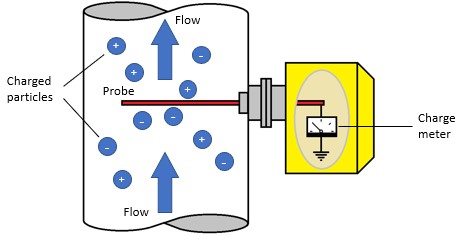The triboelectric measurement principle (in a refined design referred to as Inductive Electrification Technology) can be used to measure dust concentrations in industrial processes. It is based on the dust particles becoming electrically charged as they move through the flue gas duct. The charges are picked up by an insulated probe inside the duct and then registered.
Electrical Characteristics
When the particles come in contact with or close to the probe, they transfer their charges to the probe. The received charges are then amplified and converted into a signal which consists of two components. A DC component originate from particles coming in direct contact with the sensor (traditional triboelectric signal), and an AC component is generated by particles coming into contact as well as passing nearby the probe. In either case, the resulting electrical charge signal from the probe is then converted into a dust concentration reading by applying a calibration factor.

The operating principle of a triboelectric dust monitor.
Dependencies
The triboelectric method depends on the electrostatic properties of the dust particles, i.e. ability to carry a charge, as well as changes in the charges through e.g. electrostatic particle filters. These factors can be hard to estimate, and they can also vary widely in a running industrial process. Historically, the triboelectric method has therefore mainly been used for indicative measurements. However, development of advanced algorithms analysing the signal utilizing the inductive electrification technology can nowadays provide very accurate dust concentration measurements.
About the Author
Bengt Löfstedt
Operative Support, OPSIS AB